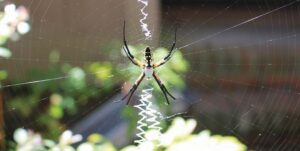Fall is the best time to observe the behavior of the black and yellow garden spider, Argiope aurantia. Its attractive appearance and size is more conspicuous in fall when the female is preparing to lay eggs before dying. These North American natives are found from southern Canada through the lower 48 states and into Mexico and Central America.
Colorful designs on the female spider’s body and legs assist with identification. Her head, a fusion of head and thorax called the cephalothorax, is covered in silver hairs. The abdomen is mottled black and yellow. Eight legs are black with yellow or orange stripes close to the body. The solid auburn male is drab by comparison. The female garden spider’s body is an inch or more in length while the diminutive male is only one-fourth of an inch long.
Argiope is programmed with the apparatus, materials, and know-how needed for weaving webs. Solo she weaves a vertical circular web as wide as two feet across among shrubs, flower, and vegetable stems, or anchored to structures like fences or windows.
The web is an extension of a spider’s sensory system and a snare for prey. Even though Argiope has eight eyes, her vision is poor. She relies on an acute sense of touch to distinguish between prey and potential mates.
Males and females communicate via the web. Males touch the web to determine if a mature female resides inside. He strums the web threads like a guitar to indicate interest. If she misreads his message, he could become prey.
The orb weaving garden spider uses different kinds of silk for various parts of the web. Gently touch web threads to feel differences. Observe the anatomy of a web from the guy lines of the outer frame to the open central hub.
Silk guy wires hold frame threads to surrounding natural or man-made structures. Frame threads create the perimeter of the web and serve as hitching posts for radial threads. The dry radial threads arranged like bicycle wheel spokes meet in the web’s central hub. Radial threads support the adhesive capture threads woven in a spiral from within the frame to the hub.
The hub is an open area where Argiope hangs head side down upon a non-adhesive white silk zigzag monogram called a stabilimentum. The monogram resulted in Argiope’s common name, “writing spider.”
What is the function of the stabilimentum? Scientists propose these possibilities:
•Protects spider by startling
predators
•Camouflage for spider
•Alerts predators to web
•Reflects ultraviolet light
thereby luring insects
•Thermoregulation
•Stabilizes web
•Prevents birds from flying
into web
•Guides males to female for
mating
•Attracts prey
The web as an aerial filter is an efficient way a spider obtains food without expending energy chasing prey. However, web construction takes a lot of energy, too. At night the garden spider eats her web and spins a new one. Web silk is protein. Eating the web recycles protein and conserves energy before spinning a new web. Rewebbing also increases a spider’s foraging success. Spiders adjust web design for feast or famine conditions.
Watch the female’s dramatic performance when an insect hits the web. She dashes to the snared victim and wraps a silk straight jacket around it before sedating the mummy with a toxic bite. Later she will sip bug juice. Female spiders can wrap prey much larger than themselves including roaches, grasshoppers, cicadas, wasps, and katydids.
But Argiope has predators, too, including lizards, snakes, birds, mantises, scorpions, and other spiders.
In fall, the female lays hundreds of eggs in a one-inch oval silk sac. The spider stays near the sac until she dies, usually with the first frost. When eggs hatch, hatchlings overwinter in the sac until spring when they emerge as spiderlings.
Argiope conducts her web work skillfully without entangling herself. Plant a spider-friendly garden for her. The garden spider is beneficial because of its role as a biological control of insect pests. One spider can eat 2,000 insects per year. Since spiders contribute to a healthy food web in the garden, there are precise actions humans can take to integrate spiders into the home landscape:
•Plant an assortment of flowering plants to attract flying insects so spiders will have abundant food.
•Provide tall, tough stems of grasses, perennials, and decorative seed heads as scaffolding for webs.
•Mulching provides protection and humidity for spiders.
•Don’t spray pesticides so there will be plenty of insects for spiders.
Celebrate garden spiders with web walks around the neighborhood to see who can find dazzling dew-spangled Argiope webs with her egg sac and the zigzag monogram.




Loading Comments